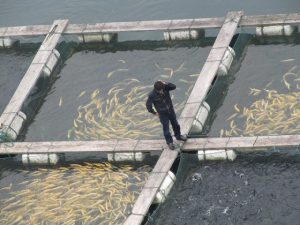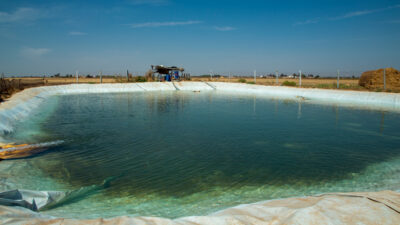 People who live in Mideastern coastal cities might understand the despair expressed in Samuel Taylor Coleridge’s Rime of the Ancient Mariner: “Water, water every where, and nor any drop to drink.”
People who live in Mideastern coastal cities might understand the despair expressed in Samuel Taylor Coleridge’s Rime of the Ancient Mariner: “Water, water every where, and nor any drop to drink.”
The poem details the effects of saltwater and thirst on marooned sailors. The ancient mariner hangs an albatross around his neck as an act of atonement for killing this bird, which his shipmates considered to be a good omen. He would not have known that the albatross has desalination glands behind its eyes. These glands concentrate salt and channel it away onto the beak. Some seabirds then sneeze the salt away.
Undrinkable saltwater stretches beyond the horizon from Alexandria, Beirut, Tel Aviv, Abu Dhabi and elsewhere in the Mideast. Fortunately, humans are now able to remove salt from seawater. Israel will soon use desalination for 75 precent of its water supply. But all existing methods are energy intensive and can have significant environmental side effects. The energy cost of desalination is so high that it can be cheaper to transport fresh water hundreds of miles even when there is a great sea on your doorstep. Libya, for example, has plans to purchase fresh water which will be shipped from the Manavgat river in Turkey. Here are some technologies which might reduce the energy and ecological cost of desalinization:
1. Reverse Osmosis
Reverse osmosis (RO) has grown to become the most common method of industrial desalination. It is also the most energy efficient option. But anyone who has ever watched water trickle out of a furiously hand-pumped RO desalinator will tell you that it requires quite a lot of energy.
Reverse osmosis works by applying pressure to salt water and using a semi-permeable ‘osmotic’ membrane to squeeze out molecules of fresh water. What consumes the energy is the application of 1000 PSI pressure to the seawater. RO uses about 3 watt-hours per liter. This doesn’t sound like much until you consider that a typical plant such as the one in Ashkelon Israel can process 330 million liters per day, consuming about a billion watt-hours of electricity, equal to the full capacity of some power plants.
One advantage of RO desalination is that it can remove other contaminants from seawater. This becomes a disadvantage if the membrane becomes contaminated and loses its efficiency.
 2. Desalination by Distillation
2. Desalination by Distillation
Squeezing water through a membrane requires a lot of energy, but not nearly as much as boiling the same amount of water would. Distillation is a well-established method of removing salt from water. 95% of global desalination capacity makes use of distillation. Seawater is vaporized and then condensed on a cooler surface. Because of the heating and cooling involved, it requires about twice the energy of RO desalination. Its key advantage that it can directly use solar thermal energy. This is important in the Mideast where lack of water and abundance of sunlight go together. But even in the desert, solar desalination capacity is only about 4 Liters per square meter of collector per day.
3. Reverse mixing entropy battery
A reverse mixing entropy battery sounds like something Zaphod Beebrox would use to power the infinite improbability drive in Hitchhiker’s Guide to the Galaxy. But it is a real technology.
First let me explain a forward mixing entropy battery. One of the laws of thermodynamics says that there is a relationship between energy and information. Entropy is a measure of disorder or ‘lack of information.’ Whenever entropy increases, energy can be extracted. When a river flows into the sea, the fresh water mixes with the sea water and loses its identity as fresh water. Information is lost so it is possible to extract energy. Mixing entropy batteries are based on nanotechnology and could eventually be used to generate electricity wherever rivers meet the sea.
Like many other electrochemical processes, the mixing entropy battery is reversible. So under the right circumstances, applying energy will separate seawater from freshwater. This recent discovery is already approaching the efficiency of RO desalination. Ask Maxwell’s demon for more details but he doesn’t give information for free, you’ll have to pay in energy.
4. Electrodialysis Desalination
Electrodialysis desalination (EDR) has also been used commercially. It relies on the fact that when salt (Sodium Chloride or NaCl) dissolves in water, it breaks into negatively charged Chlorine ions (Cl-) and positively charged Sodium ions (Na+). If an electric current is sent through seawater, Chlorine is attracted to the positive electrode and Sodium is attracted to the negative electrode. If a membrane controls the flow of ions, the water between the electrodes will have less salt.
5. Graphenes, Carbon Nanotubes and other Nanotechnology
Vaporizing, compressing and electrically zapping sea water all sound like brute force approaches to desalination, and they are. RO is the most efficient but it requires more than twice the 0.76 watt-hours/liter which should be theoretically possible. What we really need is a filter with holes just the right size to keep H2O molecules on one side and salt ions on the other. No such material exists in nature, but nanotechnology promises to allow more efficient desalination.
Ion Concentration Polarization(ICP) is one nanotechnology system has characteristics of a semiconductor. It sounds promising with an efficient 99% desalinization in a single step, but it also seems best suited for small scale systems.
Carbon nanotubes can also remove salt from seawater. Like Legos of the atomic world, carbon atoms can be put together in many different configurations. Natural carbon can be found in the form of soot, coal, diamond or graphite. Man-made carbon can take many other shape. One of the most promising is graphene.
Carbon atoms in graphene are arranged in a one atom thick hexagonal grid. The holes in this grid are small enough to hold back nearly everything, even Helium atoms, but water vapor easily slips through. This property has not yet been used for desalination but it has been used to separate water from alcohol.
Carbon can also be rolled into microscopic tubes which pack together into something resembling a RO membrane, but with potentially 20 times the water permeability. Saudi Arabia is already investing in a desalination plant based on this technology.
No Quick Fix for desalination
Regardless of which desalination technique is used, the concentrated salt removed from the water must be disposed of or it could devastate marine wildlife in the outflow region. Ideally the salt would be separated for industrial use. Otherwise its return to the sea must be managed carefully to avoid poisoning sea life.
There is no quick fix on the horizon and even the theoretical ideal desalination plant consumes quite a lot of energy and pollutes the sea. So water conservation will continue to be important for the foreseeable future
(Photos by Brian Nitz)
Engraving by Gustave Doré for an 1876 edition of Rime of the Ancient Mariner via wikimedia.





If anyone is seriously interested I have a desalinization system that can produce 120 gallons a day at 1500Watts and is scaleable to larger systems. These can be run off solar power and or wind generation making off grid applications quite feasible.
What is your email address?
A new approach to desalinate and produce some electricity from solar thermal energy indicates that it is possible to desalinate with solar thermal energy requirements under 60 KJ/Kg. (about 16KWh/M^3.)
Depending on location: at about 8KWh per day per M^2 of collector this equates to arround 500 litres/ day per square meter of collector.
Interested parties welcome to contact Guy Mercer B.SC at [email protected]
Fabulously enlightening article: suggest you pop it into envelopes and mail to the Ministries of Environment for each of the referenced ME locations.
(Of course, if you incite policy change, your handsome model may demand some royalties).